#chang tsai
Photo
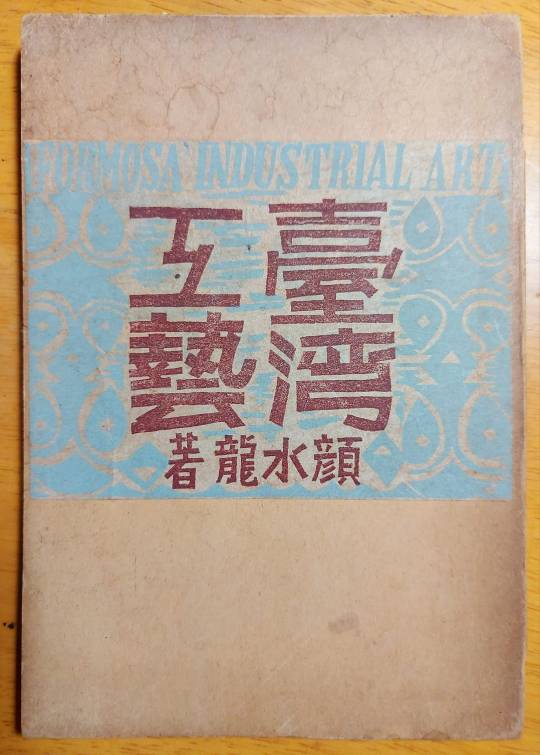


顏水龍
- 臺灣工藝
1952
29 notes
·
View notes
Text
Marry My Dead Body
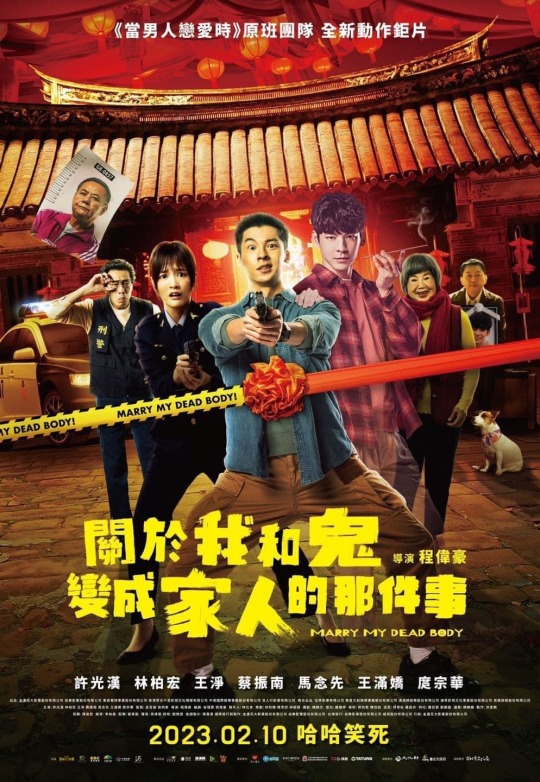
Movies watched in 2023
Marry My Dead Body (2023, Taiwan)
Director: Cheng Wei Hao
Writer: Cheng Wei Hao & Sharon Wu (based on a story by Lai Chih Liang
Mini-review:
I had so much fun watching this! I feel like the movie's tonal shifts and mixtures might be a bit too jarring for some people, but they worked perfectly for me. Most of the comedy lands pretty well, and the dramatic moments strike a nerve. There are even some effective jump-scares here and there! But the thing that takes the film to the next level is the acting. Greg Hsu and Austin Lin deliver flawless performances that really draw you in. People expecting a full-on gay romance will be disappointed, cause that's not what the story is about at all, but the chemistry between these two actors is fantastic and energetic. The directing is also dynamic and keeps you on the edge of your seat. That being said, the movie is not perfect. It tends to represent gay people in a way that feels somewhat stereotypical, and I think it could have delved much more into the social issues it addresses. I know the film has the best of intentions, but yeah, it could still be better in that regard. Anyway, Marry My Dead Body is a very fun experience, filled with humor, drama, action and great performances.
#marry my dead body#cheng wei hao#sharon wu#lai chih liang#greg hsu#hsu kuang han#greg han#greg han hsu#austin lin#lin bo hong#gingle wang#wang jing#tsai chen nan#wang man chiao#tuo tsung hua#ma nien hsien#chang zhang xing#liu kuan ting#aaron yan#chris lee#comedy#mystery#ghosts#taiwan#gay#lgbt+#lgbtq#tw homophobia#homophobia#movies watched in 2023
73 notes
·
View notes
Text



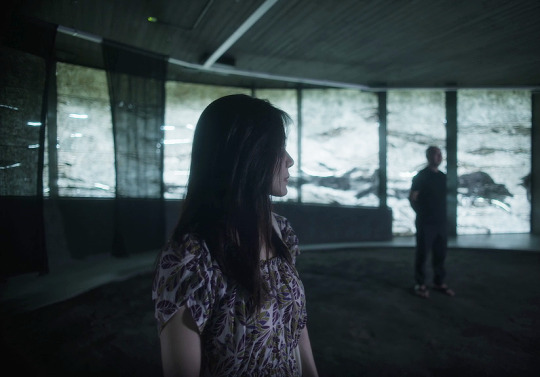
Wandering (2021, Tsai Ming-liang)
#wandering#tsai ming liang#lee kang sheng#ivy yin#screencaps#post#wanderingthunderstorm#you did say be change ....#i forgot i had this in my files for a bit and was saving it <3
21 notes
·
View notes
Note
You're in filmmaking and working on your big dream BL production, your writer is one of the best, you got decent budget, interested sponsors, a great director, a professional crew. Now, you gotta cast your actors, the mains and maybe a sidedish. Who would you chose and why? Which criteria would you apply for example age, appearance, acting style, experience, ability to create chemistry, on-screen charisma, name recognizability? Which actors would you pair and why? Make it country specific.
MY ULTIMATE FANTASY CAST + BL MASTERPIECE!
If I could have any BL in the world. What would I pick?
I kinda already did this here:
TOP 10 BL PAIRS + What They Should Play Next - I chose SamYu for the gay Descendants of the Sun, but you threw the door wide open on this one so I am pushing it. (I also did Crazy BL Actor Pairing I'd Love to See )
I hold by those picks but I’ll reboot the game a little.
Now, you gotta cast your actors, the mains and maybe a sidedish. Who would you chose and why?
(SamYu - We Best Love) in a Taiwanese production of Hospital Playlist.

So Hospital Playlist is a true ensemble piece with 5 leads, but the anchor relationship would be these two. In case you were in any possible doubt as to my ultimate bias.
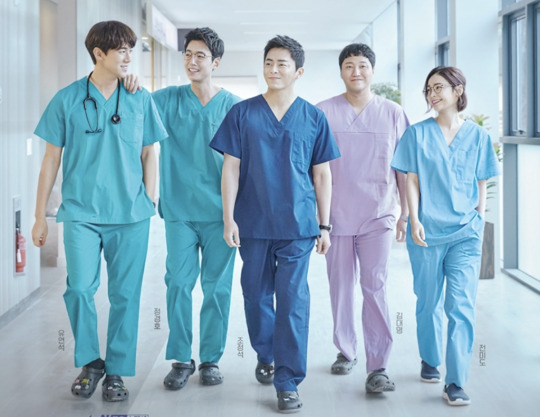
(L-R: prudish pediatrician, arrogant heart surgeon, comedic general surgeon, neurotic OBGYN, warm & brilliant neurosurgeon)
Hospital Playlist is not just one of my favorite Kdramas, it’s one of my favorite dramas of all time. I love a medical drama, it has multiple solid romances all ending happily, it’s about older characters, there are complex stories and GREAT side characters, food is vitally important, and it’s ultimately extremely comforting. It’s sadly het, tho.
So I want Taiwan to do the queer version. And I want it to get the proper treatment the way Taiwan sometimes does with their het stuff, like full on 20-30 episodes.
Hospital Playlist only it’s 5 queer surgeons, paired as follows:

Sam plays the funny single dad general surgeon (his husband left him alone with their adopted son, yadda yadda)

Yu is the kind hearted brilliant neuroscientist. I’d like to see him play a warm nerdy character for a change.
(Spoiler, these two characters are already besties who once moot-pined and eventually end up together.)
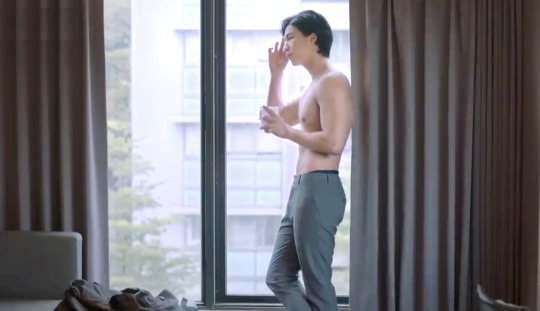
Lin Yu (OuWen from Love is Science) plays is the arrogant heart surgeon. Of COURSE HE DOES. Slayed by the military boy in the end, of course. Honestly we can pair him with Anderson Cheng again as Sam’s younger brother, but I’m not married to that pairing.

The OBGYN has to be our neurotic chaos bi character (that comedy writes itself) and I would cast Bruce He in the role. Because, he has dimples and I love him in everything and I am shallow af. He can have all the crazy exes up the wazoo. That’d be fun. I don not care who he ends up with.

I’d turn the rich prude pediatrician character into a lesbian who I want played by Aviis Zhong, because she hasn’t played enough lesbians yet. Never enough lesbians.

I want her slow pining desperate younger love interest (AGE GAP!) to be played by Tannie Huang (DNA Says Love You bestie). I think they would kill it.

I want the older administrator of the hospital adopted lesbian mom of the group to be Tammy Darshana Lai (Encore Martha). And I want her to be having her own life, quandaries and relationships.
Which criteria would you apply for example age:
I’d like it to be older characters in general. I love a high school drama but I’d like something more relatable to me, and more meaty for the actors to sink into, where being queer is there, and important, but there’s other life shit going on (ex spouses, children, career hiccoughs, side interests and hobbies).
Clearly I’m picking all over the place on actual actor ages, but the main characters would all be in their late 30s at least. The support cast of residents and students and patients so forth would be many other ages.
I’d like the Love is Science? team to direct (Tsai Mi Chieh & Chang Chin Jung).
Appearance, acting style, experience, ability to create chemistry, on-screen charisma, name recognizability?
I want mostly pretty because, as already mentioned, I shallow af. But I also want broad queer rep and diversity. So trans characters, butch, femme, various creeds and colors, all of them - in complex, capable professional doctor roles and positions of power. I want it to look like the Philippines vomited queer rep on this hospital.
It’s my fantasy medical drama, I’ll queer it up if I wanna.
I think Taiwan in general has a realistic, highly physical, slightly comedic acting style that would suit Hospital Playlist very well. (Probubly better than Korea’s style did, quite frankly.)
All the actors I chose (but Yu) are experienced and established. I think Avis and Bruce are big enough names for major draw. And SamYu as a pair are a big enough deal to pull the BL audience in spades. A show like this could take off international well and easily. Authentic queer rep is one of Taiwan’s strengths and this kind of show could showcase that for truly broad appeal, like Asia’s version of Queer as Folk, only a million times BETTER.
Did I sell you on it?

(source)
#hospital playlist#make it gay you cowards#queer it up#taiwanese drama#taiwanse bl#fantasy casting#Queer as Folk#SamYu#Sam Lin#YU#kdrama#Love is Science?#Tsai Mi Chieh#Chang Chin Jung#Encore Martha#Tammy Darshana Lai#DNA Says Love You#Tannie Huang#Aviis Zhong#Bruce He#Lin Yu#MarkOuwen#Descendants of the Sun
167 notes
·
View notes
Text



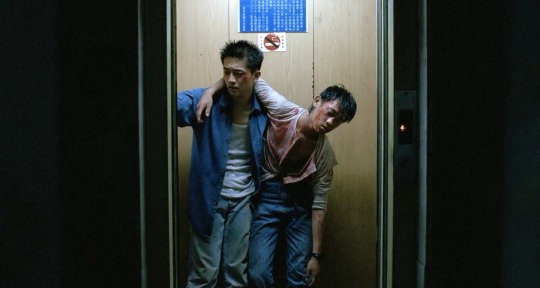

Rebels of the Neon God (1992) dir. Tsai Ming-liang
#rebels of the neon god#tsai ming liang#wang yu wen#jen chang bin#lee kang sheng#chen chao jung#film#cinematography
26 notes
·
View notes
Text
Marry My Dead Body
When you find a red envelope on the streets of Taiwan, Don't pick it up or you might be married to a ghost. read our review on Greg Lin marrying Austin Lin's Ghost in Marry My Dead Body.
#taiwanmovie #marrymydeadbody #moviereview #taiwan #greghsu #austinlin
Starting out with homophobic policeman Wu Ming-Han trying to bait young men at a gym, he is sure that all gay men carry and try to sell drugs. When this doesn’t work out and he gets scolded by his boss he works even harder to try and catch another guy after chasing him with a car for a long time. After the car crashes and they try to catch the guy by foot he fails again and is sent back out to…

View On WordPress
#Aaron Yan#Austin Lin#Chang Zhang-Xing#Chen yen-tso#Cheng Chih-wei#Cheng Wei-Hao#Chris Lee#Cliff Cho#Gingle Wang#Greg Hsu#Kurt Hsiao#Liu kuan-ting#Ma Nien-Hsien#Mandarin Chinese#marry my dead body#netflix#series#taiwan#Taiwanese Hokkien#Tsai Chen-nan#Tuo Tsung-Hua#Wang Man-Chiao#關於我和鬼變成家人的那件事
2 notes
·
View notes
Video
youtube
吾橋有水 FloodingBridge released their debut album last week, and this high-energy rocker is the most-played song so far. =D
By the way, the full album is up on YT and Spotify.
Lyrics: 張元 Yuan Chang
Music: 盧鈞右 Neon Lu (fr. 烘嗓音樂 Home Sound YT channel)
Producer / Vocal Producer / Keyboards: 盧鈞右 Neon Lu
Executive Producer: 李小天 TeddyRsLi (李小天 Teddy Li Photographer/Manager Co-Founder, Director @homesoundmusic)
Arrangement: 吾橋有水 FloodingBridge
Vocal: 莊蕎嫣 Faye.Z
Electric Guitars: 李奎綸 Kui Lun Li (fr. 打倒三明治 Sandwich Fail)
Acoustic Guitars / Bass: 林郡彥 Giu (fr. Lazy樂團)
Drums: 蔡信澤 Shin Tze Tsai
Backing Vocals written / sung by: 書帆 ShuShu (沈書帆)
Links: Instagram, StreetVoice, 吾橋有水 FloodingBridge YouTube, Spotify
Faye Links: StreetVoice, Instagram, 莊蕎嫣 Faye.Z YouTube, iNDIEVOX and she has done covers w/ 烘嗓音樂 Home Sound YT
#莊蕎嫣 Faye.Z#吾橋有水 FloodingBridge#李奎綸 Kui Lun Li#林郡彥 Giu#蔡信澤 Shin Tze Tsai#書帆 ShuShu (沈書帆)#盧鈞右 Neon Lu#張元 Yuan Chang#music video#taiwan
14 notes
·
View notes
Text
s5 mc application form


tagged by the lovely @lasswithumor
lan has a full profile which can be viewed here!!
lan is portrayed by lu keran
basically i’m just gonna let anyone join in fufu!!
#i changed some of her answers for some variation#ISN’T SHE LOVELY THOUGH?#they also like presenting masc fufu#lan tsai#litg#love island the game#litg s5#litg mc
10 notes
·
View notes
Photo
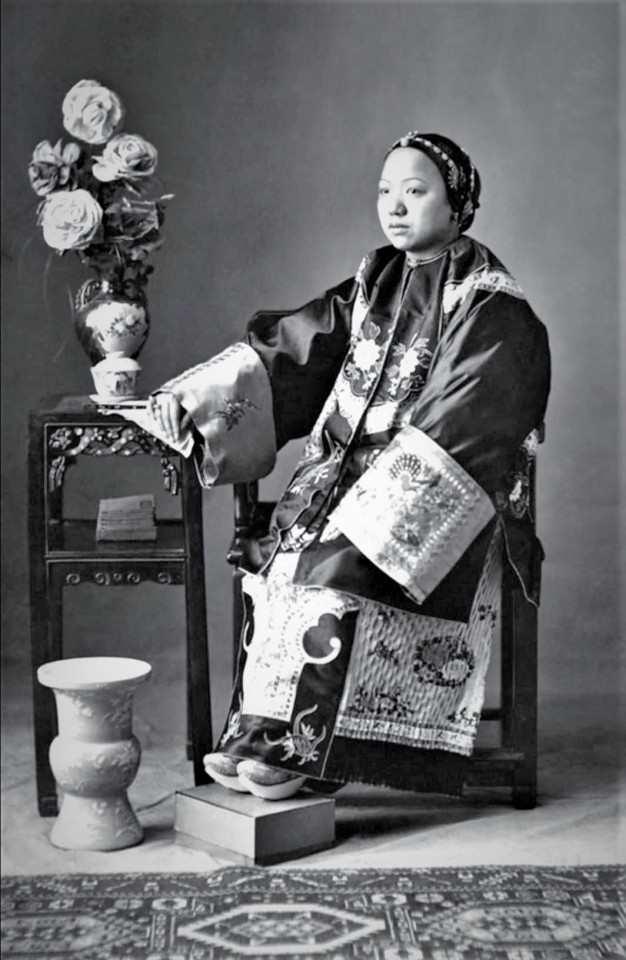
Portrait of a lady in San Francisco, no date. Photographer unknown (but based on the configuration of the floor vase, possibly William Shew’s studio).
Images of Chinese Pioneer Women on the Urban Frontier
Chinese American women have a rich and complex history that spans more than 170 years. From the mid-19th to the early 20th century, Chinese American women faced many challenges and obstacles as they worked to establish themselves in the United States.
Although few in number, women were among the first wave of Chinese arriving in the United States during the latter half of the 19th century, largely during, and as a result of, the California Gold Rush. When the American ship Eagle arrived at San Francisco on February 2, 1848, two Chinese men and one woman supposedly accompanied a Charles V. Gillespie upon his disembarking. According to H.H. Bancroft in his History of California (San Francisco, 1890, Vol. 7, p. 336), the Chinese men left for the hills after the news of the discovery of gold, and the woman remained as a servant in the Gillespie household.

Portrait of a lady, no date. Photograph possibly by Lai Yong (from a private collection).
At this time, Chinese women were virtually absent from the American West, as they were barred from immigrating to the United States by discriminatory laws such as the Page Act of 1875 (Sect. 141, 18 Stat. 477, 3 March 1875). The law represented the first restrictive federal immigration law in the United States, which effectively prohibited the entry of Chinese women, marking the end of open borders. (Seven years later, the 1882 Chinese Exclusion Act would effectively ban immigration by Chinese men.) Named after its sponsor, Representative Horace F. Page, a Republican representing California who introduced it to “end the danger of cheap Chinese labor and immoral Chinese women,” the law technically barred immigrants considered “undesirable.” This included women who were believed to be prostitutes, as well as women who were considered to be morally loose or of questionable character.

Portrait of a woman, c. 1870. Photographer unknown (from the collection of the California Historical Society).
Chinese women who sought entry to the US at San Francisco would be interrogated, and their faces compared with images produced by the then-growing photographic identification industry to serve the government’s need to screen and deny entry to immigrants.

William Shew’s Pioneer Gallery, young woman with fan, after 1880, albumen cabinet cards (from the collection of the California Historical Society).
According to historian Eithne Luibheid, Chinese women were subject to this method of identification prior to any other immigrant group because of the “threat of their sexuality to the United States.” Thus, Chinese women had to demonstrate that they grew up in respectable families and that their husbands could afford to support them in the United States. Immigration official considered a range of clues about an entrant’s character based on the appearance of the body and clothing in an effort to differentiate between bona fide wives and mothers from prostitutes. In contrast, men were not required to carry photographs or match photographs that had been sent in advance to San Francisco Port authorities.
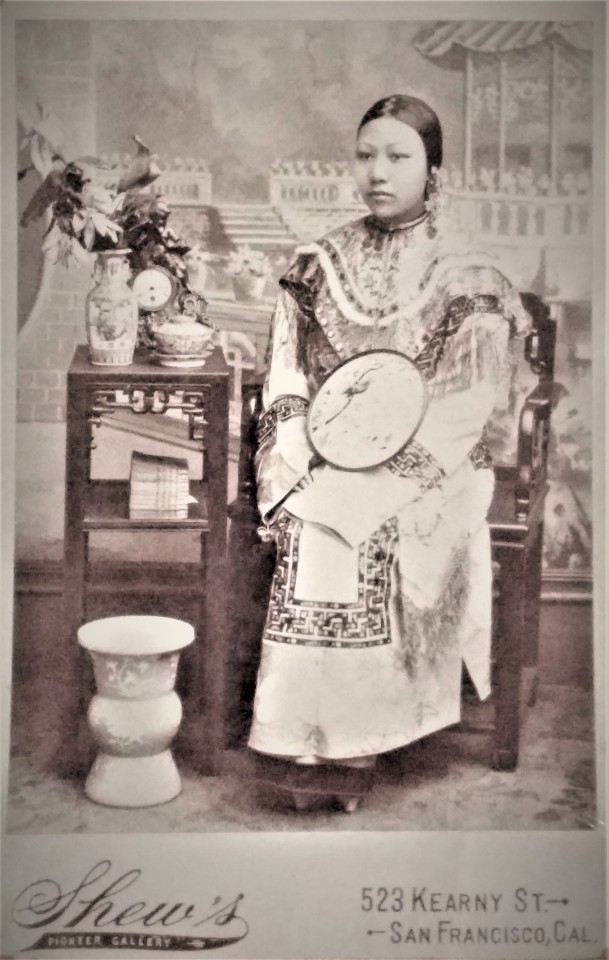
William Shew’s Pioneer Gallery, young woman with fan, c.1880, albumen cabinet cards, from the collection of the California Historical Society.
It would not be unreasonable to conclude that the challenge posed by the entry of Chinese immigrant women drove the deployment of photograph technology on a mass basis as a principal means by which the government sought through each stage of the examination process to ensure that unqualified women could not be substituted for women who were properly questioned at any point in time.
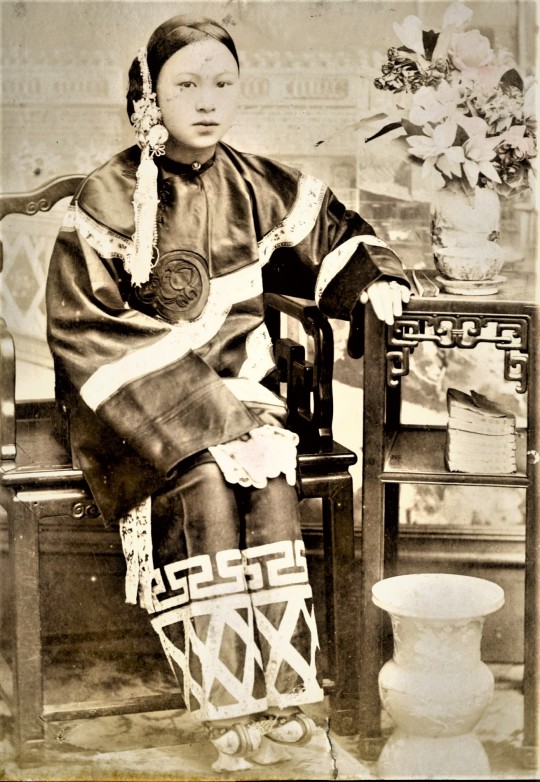

Portraits of two different women in the collection of the Stanford Manuscripts division of the Stanford University Libraries. Based on the pattern of the backdrop and the decorative furnishings, the two portraits above appear to have been taken in the Shew’s studio near Chinatown at 523 Kearny Street in San Francisco. Two centuries later, the pair of Stanford photos prompts speculation why the women in both photos wear identical outfits. The coincidence raises the question about whether the women were related, or if the studio provided the garment for its customers to help them prove their bona fides as daughters or wives of a merchant and, thus, eligible to stay in the US.
The Page Act had a profound effect on Chinese American women, as it was used to justify the exclusion of Chinese women from the United States. Many Chinese women were denied entry on the grounds that they were suspected of being prostitutes, despite having no evidence to support these claims. The 1875 law represented the opening shot in a larger legislative war against Chinese Americans, which included discriminatory laws such as the Chinese Exclusion Act of 1882. These laws contributed to a hostile environment for Chinese Americans, and made it difficult for Chinese women to establish themselves in the United States.

Portrait of a 19th century Chinese woman, no date. Photographer unknown (from a private collection). Based on the pattern of the backdrop, the photograph was probably taken at the studio of either Chin K. Toy of 824 Clay St. or L.H. Sun of 827-1/2 Washington Street.
The few Chinese women who did come to the United States often faced extreme poverty and discrimination. Women who lacked the financial security of merchant spouses worked as members of the laboring class, toiling long hours like their husbands. In the late 1870s, a few could be found as domestics or in intensive labor industries as seamstresses, washerwomen, shirtmakers, gardeners, and fisherwomen.
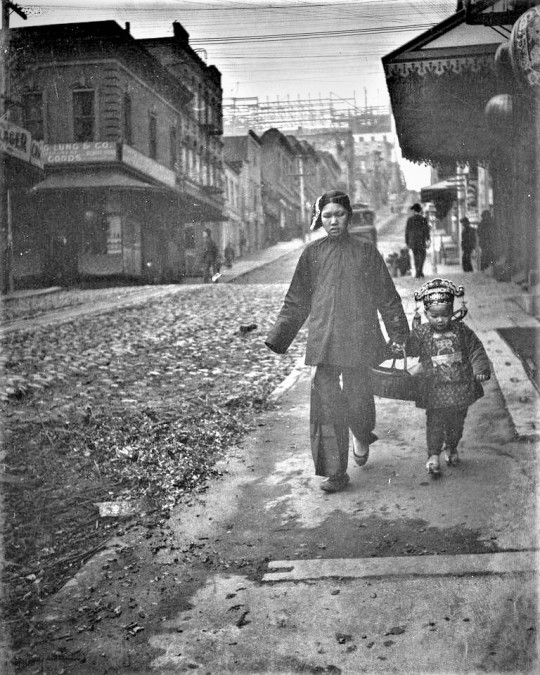
“Carrying New Year Presents” c. 1900-1905. Photograph by Arnold Genthe (from the Genthe photograph collection, Library of Congress, Prints and Photographs Division). The young woman in the photo appears to have been a servant to the family of prominent merchant Lew Kan. The boy in the photo is Lew Bing Yuen, the older son, who also appears in Genthe’s well-known photo “Children of the High Class.” The woman’s plain dress (in contrast to the boy’s seasonal garb), shows clearly that she was not the boy’s mother or sister. The pair is walking east on Sacramento Street from its intersection with Dupont Street.
The servant seen in the above photo – nanny or otherwise – could very well be characterized as a mui tsai (妹仔; canto: “mui jai”). The “little sister” were essentially young Chinese women who worked as domestic servants in China, in virtual slavery to affluent households or brothels. The young women were typically drawn from poor families and sold at young ages to merchant families during this period. This form of charitable adoption continued on the condition that they would be freed through marriage. The system spread to Hong Kong, Southeast Asia, and to the US. The practice didn’t disappear with the Republic’s founding, and the rescue of such women was the objective of Protestant reformers, notably in San Francisco. Mui jai would start to disappear only after the establishment of effective 2nd and 3rd generation families in the US later in the 20th century.
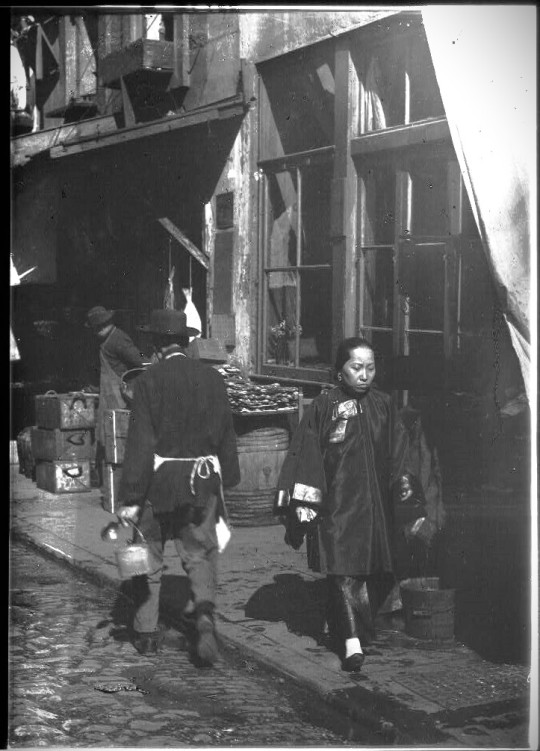
“A Woman House Servant” c. 1896 - 1906. c. 1900-1905. Photograph by Arnold Genthe (from the Genthe photograph collection, Library of Congress, Prints and Photographs Division). Based on her plain attire and walking unaccompanied on a Chinatown street, historian Jack Tchen has suggested that the woman served as a domestic servant for one of the neighborhood’s wealthier families.

“An Afternoon Airing” c. 1900-1905. Photograph by Arnold Genthe (from the Genthe photograph collection, Library of Congress, Prints and Photographs Division). The little girl is dressed in New Year’s festive clothing, and she is walking on Dupont Street with her amah. As historian Jack Tchen observes about this photo, the girl’s parents were wealthy enough to employ a domestic servant.
In family-run operations, like laundries or grocery stores, the line between business owner and laborer blurred, and wives were often compelled to work alongside their husbands to keep their businesses afloat.

“Picture Bride Yook Gee” c. 1898. Photographer unknown (from the collection of the San Francisco Public Library).
“And what of those Chinese women who came to America as wives?” asked historian Iris Chang wrote in her book, The Chinese in America. “In China, society mandated that a married woman’s life centered on the family, serving them from cradle to grave. According to one school of ancient Chinese philosophy, the “Three Obediences” dictated that she first obey her father, then her husband after marriage, and finally her eldest son when widowed.”
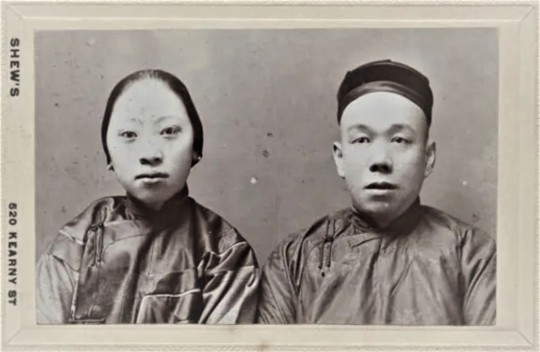
A portrait of a merchant and his wife, no date. Photograph by Shew’s studio (from a private collection). The joint portrait likely served as proof of the woman’s status as a merchant’s spouse and to avoid the restrictions imposed by the Page Act of 1875 which limited the entry of Chinese women to the US so severely that Chinese were effectively precluded from establishing families.
Chang on merchant spouses:
“Because the average worker could not afford to support a family in the United States, most Chinese women emigrants who were not prostitutes were wives of merchants. Most had grown up in modest but respectable families in small villages near Canton. They tended to be middle-class, because upper-class families would not allow their daughters to marry outside China, and because many Chinese merchants in the United States considered working-class women beneath them. . . .

“No. 108. Chinese Merchant and Wife, San Francisco, Cal.” c. 1875. Photograph by John James Reilly (from the collections of the Oakland Museum of California and the New York Public Library).
“Having been raised in a protected, insular household, the typical merchant’s wife had never ventured far beyond her village until journeying to the United States. Even more problematic was the fact that the middle and upper classes in China practiced the nine-hundred-year-old tradition of bandaging a young girl’s toes under the ball of her foot, reducing the foot to a length of five or even three inches. Reflecting the same impulse as the Western fashion of warping the female ribcage with corsets, foot-binding existed primarily to symbolize a family’s wealth and power, advertising its ability to support a nonworking, purely ornamental human being.

“B 5493 Chinese Girl with Bound Feet” c. 1880. Photograph by Isaiah West Taber (from the collection of the Bancroft Library).
“For many of the wives, home in the United States was nothing more than a gilded prison, where they were jealously guarded as treasured possessions. Some Chinese immigrant women could easily count the number of times in their lives they had ever stepped outdoors. “My father traveled all over the world,” one Chinese American remembered, “but his wife could not go into the street by herself.” Only during holidays were some permitted to venture out, accompanied by a chaperone. . . .”
“No doubt many Chinese men felt they had good reason to keep their wives under lock and key. The scarcity of women in the West and the violence of frontier society posed a very real danger of kidnapping or molestation in the streets. A bound-foot woman could neither run from assailants nor fend off attacks. Indeed, with several toes rotted away from foot-binding, she could hardly walk—or even remain standing—for an extended period of time. The annals of nineteenth-century California recount many stories of helpless Chinese women being thrown down into the mud, dragged by the hair, pelted with stones, their clothes and earrings yanked off.
“So perhaps staying indoors was safer, though less than stimulating. One wife whiled away the hours playing cards with her servant, looking after her son, gossiping with neighbors, or hiring a hairdresser or a female storyteller to entertain her. . . .”
The photographic record, however, suggests that Chang may have overstated the limitations on movement by the women of Chinatown at least toward the end of the 19th century.

“Single-file Promenade on Post St. San Francisco Cal” c. 1890. Photograph by A.J. McDonald (from the Marilyn Blaisdell collection).
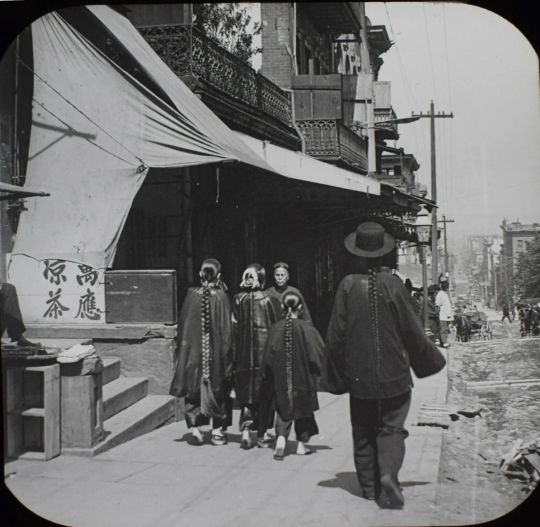
“Going to the Matinee, Chinatown” c. 1889. Photograph by A.J. McDonald (from the Jesse B. Cook collection of the Bancroft Library). In this striking photo showing the hairstyles of Chinese American women of the time, a trio of women are shown walking east on Washington Street (from Stockton Street) and down the slight hill. The women with the longer braids are unmarried (as was the fashion of the time), and probably daughters following their mother. McDonald’s title of the photo, and the known locations of Chinese opera venues on this block provide context for the trio’s walking this particular street during the day; they are either headed to the Royal Theatre at 836 Washington Street or the Grand Theatre at 814 Washington toward the eastern end of the block.

Three women walking on Kearny Street on the outskirts of San Francisco Chinatown, c. 1896-1906. Photograph by Arnold Genthe (from the Arnold Genthe collection at the Library of Congress).
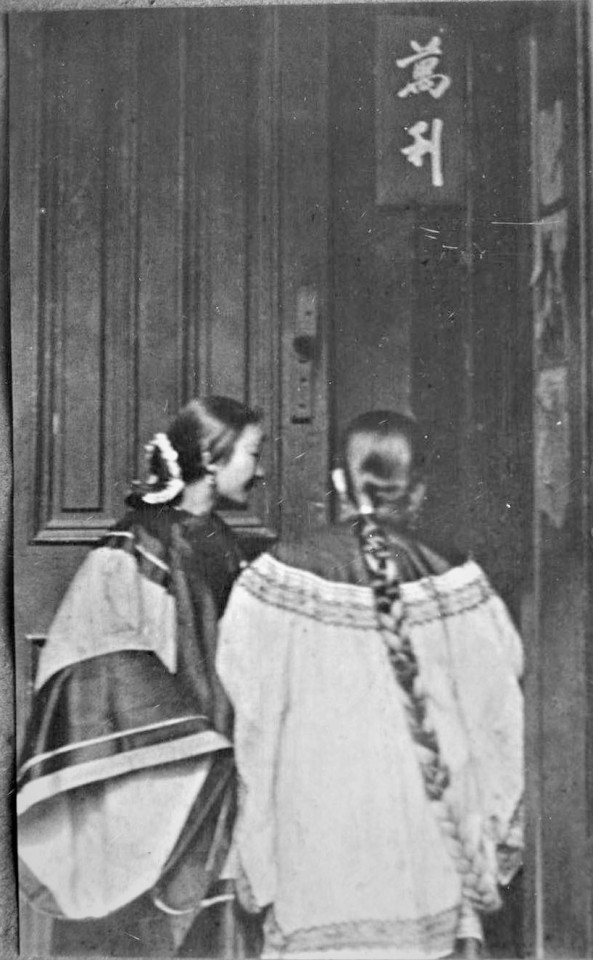
“Dressed for the Feast,” c. 1896-1906. Photograph by Arnold Genthe (from the collection of the Library of Congress). For this photo taken at 814 Washington Street, historian Jack Tchen wrote as follows: “The single braid of the woman on the right indicates that she is not married. Interwoven with the hair is raw silk to extend the length of the queue. In contrast to the men, women did not shave their foreheads. Once every seven years the ‘Good Lady Festival’ was celebrated in Tangrenbu, during which all the women in the quarter were accorded the same rights as men and allowed to walk the streets freely.”
In her essay “The Chinese Woman in America,” Edith Maud Eaton, a Eurasian writer who used the pen name Sui Sin Far, offered a glimpse of merchant women’s lives:
“Now and then the women visit one another. They laugh at the most commonplace remark and scream at the smallest trifle, they examine one another’s dresses and hair, talk about their husbands, their babies, their food, squabble over little matters and make up again, they dine on bowls of rice, minced chicken, bamboo shoots and a dessert of candied fruits. In contrast, other Chinese wives did not enjoy the luxury of idleness.”

“Golden Gate Park. 1890s.” Photographer unknown (from the collection of the Bancroft Library). As the above photo of a family in Golden Gate Park attests, San Francisco’s first Chinese residents also enjoyed the park. However, such daytime leisurely pursuits, which presumably included transportation to the western half of the city either by horse-drawn cart or cable car, would have been the privilege of a merchant’s household during the 19th century. The Bancroft collection’s striking photo captured not only a very rare instance of a Chinese family in the park but also the social standing of a fan-carrying, male head of household; he appears to have been accompanied by a young wife, his mother, and either a maid or an aunt of the three children shown in the photo.
As Chang writes further:
“Difficult as her life could be, the typical Chinese wife had more power in the United States than she could have achieved in her home village. First and most important, she had escaped the tyranny of her mother-in-law. In China, a daughter-in-law lived with her husband’s family and endured her husband’s mother’s hazing until she gave birth to a son; bearing a male child validated her existence and earned her the respect of the family. Her power grew with each additional male child and climaxed when she became a mother-in-law herself, attaining the authority to perpetuate the tradition by bullying her sons’ wives.”
Despite these challenges, Chinese American women formed close-knit communities and found ways to support each other. They played important roles in the development of early Chinese American society, providing care for families, organizing social events, and raising funds for community causes.

“No. 142. Chinese Woman and Child. San Francisco, Cal.” c. 1870-1889. Photograph probably by John James Reilly (from the collection of the Bancroft Library). This studio stereograph of a Chinese mother and child represents more than venerating the relationship of mother and child, or even the mere striving for respectability by Chinese America’s merchant class. Such photographs conferred on pioneer Chinese American women and mothers often crucial legal advantage in the US immigration process.
Chang:
“Perhaps most significantly, the Chinese emigrant wives also mothered a tiny population of American children. In 1876, the Chinese Six Companies estimated that a few hundred Chinese families lived in America, and perhaps one thousand Chinese children. In the long run, these infants, the first generation born in America, would enjoy more rights and privileges in the United States than their immigrant parents. Most were too young then to know that heated racial discussions were under way in Congress and across the country, negotiations about civil rights that would profoundly affect their future.”

Mother and child, San Francisco CA, no date. Photographer unknown.
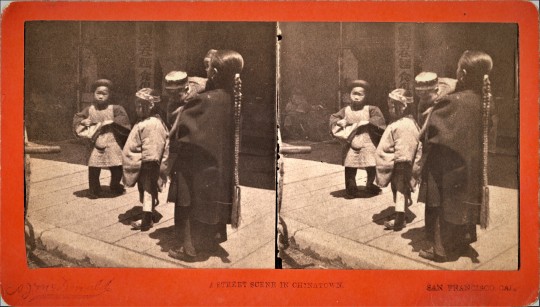
“A Street Scene in Chinatown. San Francisco, Cal.” c. 1881. Photograph by A.J. McDonald (from a private collection).

Mother and child, San Francisco CA, c. 1880. Photograph by William Shew (from a private collection).
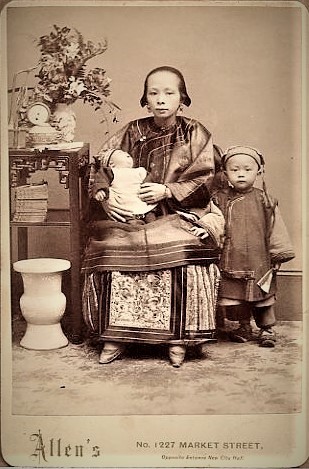
Chinese mother and two children, c. 1880. Photograph by Allen’s (apparently using props identical to those seen in Shew’s studio portrait) from a private collection.
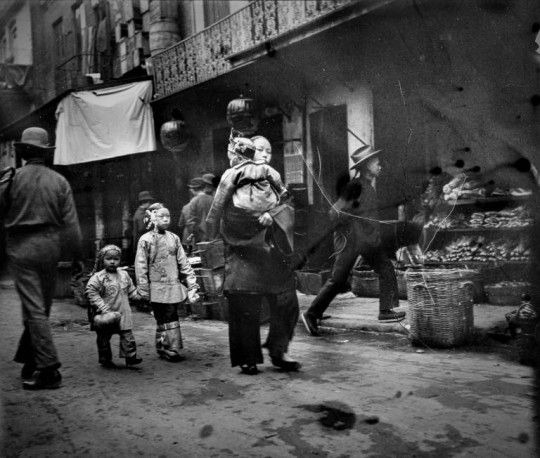
“Woman and children walking down a street, Chinatown, San Francisco,” c. 1896-1906. Photograph by Arnold Genthe (from the Genthe photograph collection, Library of Congress, Prints and Photographs Division).
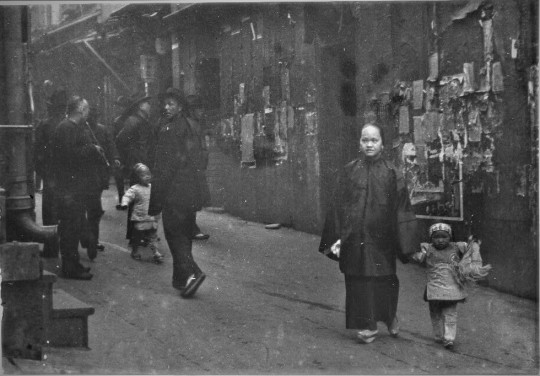
“Woman walking down a street with a child,” c. 1896-1906. Photograph by Arnold Genthe (from the Genthe photograph collection, Library of Congress, Prints and Photographs Division).
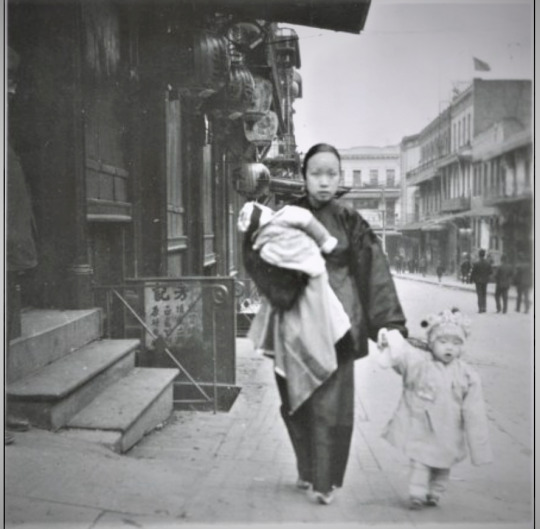
A mother and two children walking south along Waverly Place in old San Francisco Chinatown at the northwest corner of the intersection with Clay Street, c. 1900. Photographer unknown (courtesy of the National Archives; photo also in the collection of the California Historical Society). The elaborate headdress worn by the daughter at right indicates that the photo was probably taken during the New Year holidays.
Iris Chang's book, The Chinese in America: A Narrative History, provides a detailed account of the lives of Chinese women prostitutes in the 19th century. According to Chang, many Chinese women were forced into prostitution due to poverty, lack of opportunities, and gender inequality. These women were often sold or kidnapped and transported to the United States, where they were forced to work in brothels and other sex establishments.

Portrait of a simply dressed, unadorned girl, c. 1860s – 1890s. Photograph by E.W. Baker (from the Cooper Chow collection at the Chinese Historical Society of America). This image represents an unusual departure from the formal portraiture made to show well-being and status of Chinese women, especially merchant spouses or daughters. According to CHSA archivist Palma You, “the lack of shoes, plain clothing and hair, straightforward gaze and stance, and lack of props imply she may have been photographed to show ownership or perhaps to provide information for a future sale as a servant, slave, prostitute, or a mui tsai, known as "domestic slave girl.”
“The mui tsai, from Cantonese meaning little sister [妹仔; Canto: mūi jái] , was a cultural carryover from China;” wrote CHSA archivist Palma You. “[T]he system was generally regarded as a form of charity for impoverished girls. Under the system, poor parents sold a young daughter into domestic service, usually stipulating in a deed of sale that she be freed through marriage when she turned eighteen. Girls sold to rich and benevolent owners supposedly benefitted from the system. Well fed, clothed, and sheltered, they were known to establish long-lasting affectionate relationships with their mistresses. In contrast, Chinese girls kidnapped, lured, or purchased from poor parents and trafficked into California were considered chattel, without family, language skills, or the ability to negotiate in a foreign land, would ‘become household slaves, or, more probably, prostitutes for the rest of their lives.’ (Wu, 2001).
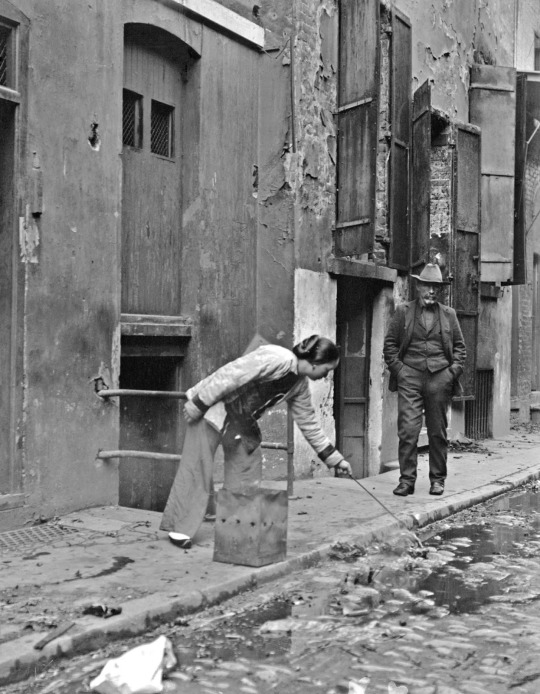
“The Street of the Slave Girls,” c. 1900-1905. Photograph by Arnold Genthe (Genthe photograph collection, Library of Congress, Prints and Photographs Division). “This woman is burning special prayer papers in the square incinerator can,” wrote historian Jack Tchen. “This is the Buddhist ritual practiced twice a month, at half-moon and full moon. Genthe entitled this photograph ‘The Street of the Slave Girls.’ Although there was no street by that name in English or Chinese, the highest concentrations of Chinese prostitutes were on Bartlett Alley and Baker’s (or Sullivan’s) Alley. The woman shown in this photograph is wearing very plain work clothes, and it is difficult to say if she was a prostitute or housewife.”
As Palma You of the Chinese Historical Society of America writes:
“Chinese girls and women fell victim to a notorious system of slave trafficking, shrewdly devised by Chinese secret societies called ‘tongs,’ during the 1800s and early 1900s in San Francisco. Many San Francisco officials condoned—indeed, supported this slave trade... (Wu, 2001). Research shows some mui tsai were not perpetual victims and demonstrated great strength in the face of adversity as they strived to improve their own conditions and prospered as a madam. A few become wealthy supporting themselves in the business. The mui tsai system persisted until the first half of the 20th century. By the 1920s the system pretty much phased out.”
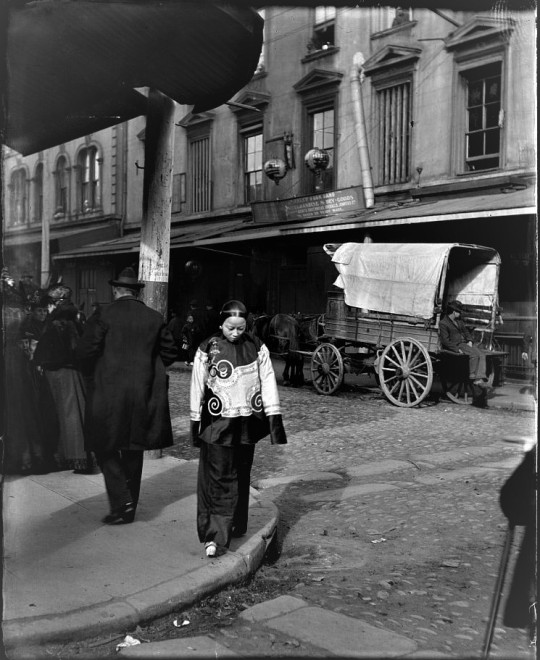
“Slave Girl in Holiday Attire,” c. 1900 -1905. Photograph by Arnold Genthe (Genthe photograph collection, Library of Congress, Prints and Photographs Division). This image was captured at the intersection of Dupont and Jackson streets. “The baroque-style Globe Hotel,” wrote historian Jack Tchen, “now occupied by Chinese, stood on the northwest corner, from which tours of Chinatown often started. Jackson Street was the red light district of Chinatown.” The term “slave girl,” Tchen asserted, “was used loosely to designate Chinese women sold on contracts. This woman is said to have been an especially beautiful and popular prostitute. It was fairly unusual for a woman to walk un-escorted in public.”
Chinese women prostitutes faced a range of challenges and dangers, including physical and sexual abuse, disease, and discrimination. They were also subjected to restrictive laws and regulations that further limited their freedom and autonomy.

Young woman walking with apparent escort(s), no date. Photographer unknown (from the Cooper Chow collection at the Chinese Historical Society of America). Research about this image is continuing, but the collector asserts that this rare image shows a slave girl probably walking on Dupont Street, accompanied by possibly two Chinese bodyguards and the non-Chinese man seen at the left of the photo.
“In the 19th and early 20th centuries, Jackson & Washington Streets were lined with ‘cribs,’ makeshift twelve-by-fifteen-foot stalls where the favors of Chinese girls could be purchased. The cribs were generally divided into two rooms by a curtain; through the inset barred window in the narrow door, the girls enticed men by displaying their upper bodies.”
-- From Dr. Weirde's Guide to Mysterious San Francisco.
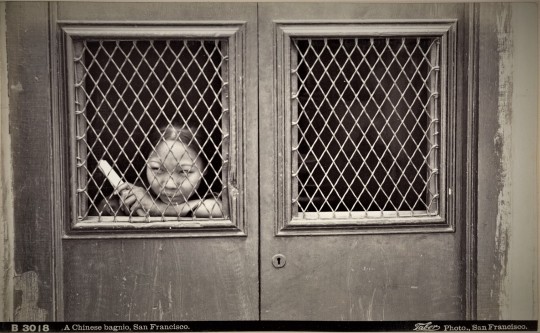
“B 3015 A Chinese bagnio, San Francisco” c. 1885-1888. Photograph by Isaiah West Taber (from the Martin Behrman collection and the collection of the Bancroft Library).
The experiences of Chinese women prostitutes were shaped by larger social and economic forces. The Page Act compounded the exclusions against Chinese immigration to the United States, and it perpetuated the marginalization and exclusion of Chinese women. The oppressive law (combined with anti-miscegenation laws), created a scarcity of women and, hence, drove the demand for, and growth of, the American sex industry to serve Chinatown’s bachelor societies in the American West.

“B 3018 A Chinese Bagnio, San Francisco” c. 1885-1888. Photograph by Isaiah West Taber (from the Martin Behrman collection, courtesy of the Golden Gate NRA, Park Archives). Woman standing in doorway of alley. View south on an as yet unidentified alleyway. The number of the negative suggests that Taber took this photograph of the alleyway (Bartlett?) after the preceding photo depicting a woman behind the window screen.

“3722 Chinese Bagnio. Chinatown, S.F., Cal.” C. 1890. Photograph by Isaiah West Taber (from the Marilyn Blaisdell collection and the Bancroft Library).

Untitled, c. 1880s. Photographer unknown published by Schoene of San Francisco (from a private collection). The building facade appears adjacent to the frontage of the Chinese bagnio building photographed by I.W. Taber.
Despite obstacles, many Chinese women prostitutes were able to develop their own support networks and communities, often centered on their brothels and other sex establishments. The historical record is replete with examples of agency and resilience, as Chinese women often found ways to resist and challenge their oppressive conditions.
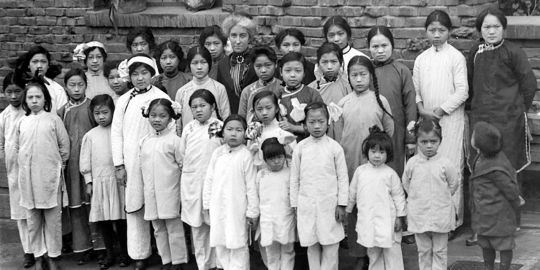
Tye Leung, second from left, back row, stands with a group of children and staff from the Presbyterian mission where she worked with Donaldina Cameron, center, a crusading anti-prostitution and anti-trafficking activist. Photo courtesy of the California History Room, California State Library, Sacramento, California. After marrying a white man in defiance of the state’s anti-miscegenation statute, Tye Leung Schulze she became the first Chinese American woman to work for the US federal government and an advocate for trafficked women, as well as the first to vote in the US when she cast a ballot in San Francisco on May 19, 1912.
As Chinese American communities grew and established themselves in cities across the United States, Chinese American women continued to face discrimination and prejudice. They were often paid less than their male counterparts, and were denied opportunities for education and advancement. However, they also worked tirelessly to improve their communities and secure a better future for their families. Despite the ongoing challenges they faced, Chinese American women remained resilient and determined. They continued to make significant contributions to American society, while making important strides in the face of extreme adversity.
Many Chinese American women formed women's organizations and worked to improve health care and educational opportunities for women and children. By the first quarter of the 20th century, they had established themselves as key participants in the lives of their communities, working to create a better future for themselves while creating first sizeable second generation of Chinese Americans.

The board of directors of the Chinatown YWCA, c. 1930. Photographer unknown (from the collection of the Chinese Historical Society of America). To view a video by documentarian Felicia Lowe about the establishment of the Chinese YWCA go here.
The history of Chinese American women from 1849 and into the 20th century is one of struggle and perseverance in the face of adversity. Despite facing discrimination and prejudice at every turn, these women formed strong communities, worked to improve their communities, and played important roles in shaping the early history of Chinese in the United States.
Let us now praise pioneer Chinese American women.
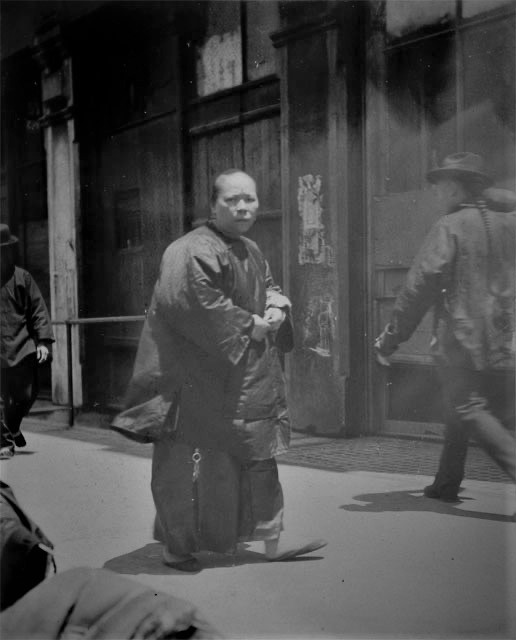
Woman walks in an alleyway of San Francisco Chinatown, no date. Photographer unknown.

Portrait of Chinese woman, no date. Photographer unknown.
[updated 2023-3-13]
#Chinese American pioneer women#Page Act of 1875#William Shew's Pioneeer Gallery#Chin K. Toy#L.H. Sun#Arnold Genthe#J.J. Reilly#Chinese Bagno#I.W. Taber#Iris Chang#San Francisco Chinatown women#mui tsai#Tye Leung Schulze#E.W. Baker#Allen's
4 notes
·
View notes
Text
Using celebrities I know nothing about as references because I think they look slightly like comic book characters let’s gooo ✨
#the cass drawing was me referencing from Lauren Tsai and now for Dick I’m looking at Connect R#(who I think looks like Dick if I ignore the facial hair and change his hair)#(he’s Rromani as well which was what I’ve been looking for.)#heroesriseandfall#my art#also okay Dick with long hair >>>
2 notes
·
View notes
Photo

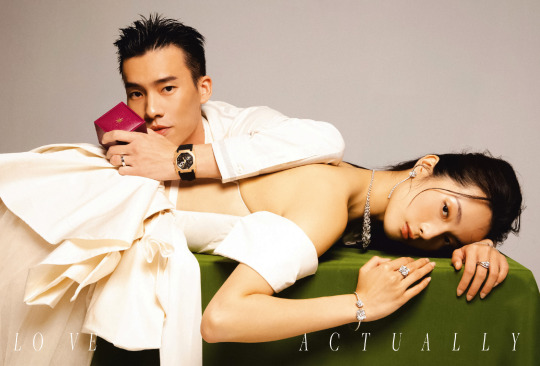

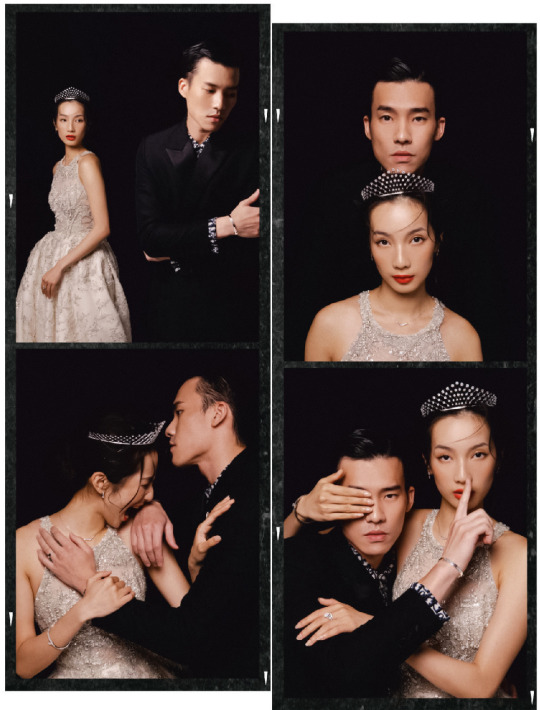
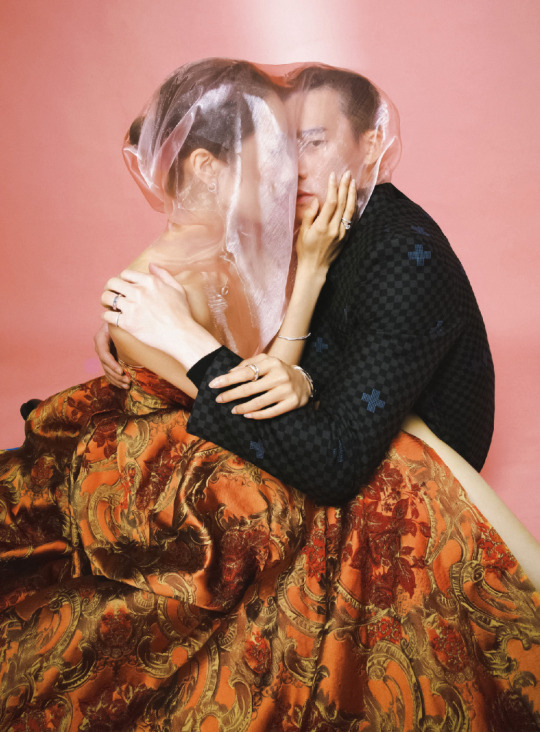

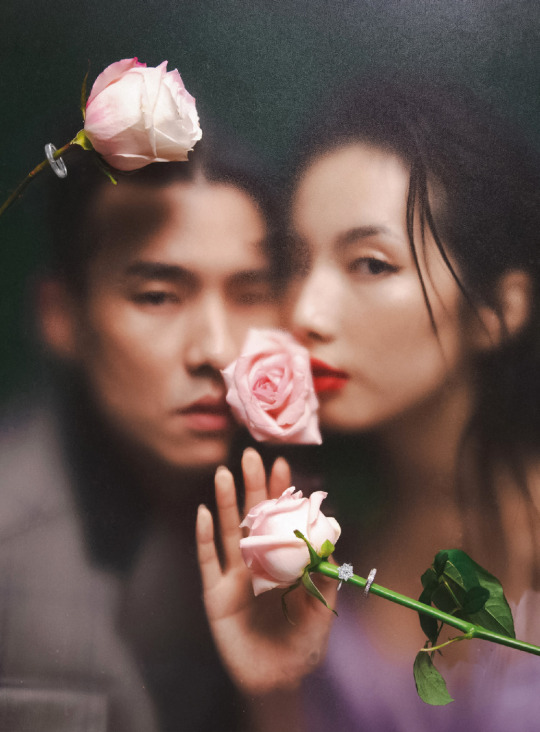
Vogue Taiwan June 2022
LOVE ACTUALLY
Photography: Johnny Lu
Styling: Saem Xu
Hair: Jiun Yu Chang
Make-up: Peiz Ju
Models: Kate Tsai & Po Wei Cheng
2 notes
·
View notes
Text
listening to Mad Tsai's killer queen and thinking "i could change her"
5 notes
·
View notes
Text
Hello Ghost!

Movies watched in 2023
Hello Ghost! (2023, Taiwan)
Director: Hsieh Pei Ju
Writer: Chou Ching Wen
Mini-review:
I have to say I expected more from Hello Ghost!, but it's still an okay movie. The cast is great, and the final plot twist did caught me by surprise. On top of that, there are a lot of funny scenes, and the script has a pretty solid sense of humor. However, the story moves at such a hurried pace that it barely takes time to set up the major plot points and the characters' development. I don't know, I feel like it would have been a much richer movie if it had let the story simmer a bit more. Also, the film includes some pretty dark themes that might be triggering, even if they are approached with a somewhat lighthearted, comedic tone. I'd recommend looking up some content warnings.
#hello ghost#hello ghost!#hello ghost 2023#hellow ghost taiwan#hsieh pei ju#chou ching wen#tseng jing hua#ivy shao#shao yu wei#lu yi ching#chang tsai hsing#tsai jia yin#hong jun hao#bai jing yi#ken hsieh#xie kun da#comedy#ghosts#supernatural comedy#drama#taiwan#taiwanese movie#movies watched in 2023
2 notes
·
View notes
Text
Location: Glazed Finish, Brooklyn
Status: Closed Violet starter for Marina ( @somethingexquisite )
Violet exhaled loudly as she cleaned some wet clay from her forehead, a strain of her curly hair falling stubbornly between her eyes as she worked tirelessly to shape the still manageable clay into a hollowed bust that would certainly become a flower vest on her art studio. Normally, she'd work with her own equipment there at her own pace, surrounded by her greenery, listening to music and drinking wine but he had lend it to a friend for a few weeks whilst they worked on a large piece of art and alas, she was left to her own devices when it came to her own art, reason why she had decided to visit her friends at Glazed Finish and work on her day off.
Just as she was molding the features on the bust to look somewhat decent, she realized she had ran out of material for the last couple of details and asking the owner for more seemed like a waste of material as the details she had left to do where minimal. Alas, she turned to the person nearest to her, grinning widely as she did so. "Hey, oh, that's really nice" she said, looking down at the other's own creation "Do you happen to have any spare clay per chance? If not that's alright, I can get away with leaving this incomplete just thought I'd ask. Do you like pottery?"

#📂 ⤷ 𝚏𝚒𝚕𝚎𝚍 𝚞𝚗𝚍𝚎𝚛 : 𝚟𝚒𝚘𝚕𝚎𝚝 / interactions#📂 ⤷ 𝚏𝚒𝚕𝚎𝚍 𝚞𝚗𝚍𝚎𝚛 : 𝚟𝚒𝚘𝚕𝚎𝚝 / ft. marina tsai 01#this comes to you by the wheel of names who chose the activity and the muse i wrote it for; blame them#lmk if you need me to change anything<3#im sorry this is so late!
1 note
·
View note
Text
EVIL Strikes with Thousands of Disastrous, Deadly Fangs! "Calamity of Snakes" reviewed! (Unearthed Films / Blu-ray)
Save the Date! “Calamity of Snakes” Slithers onto Blu-ray and DVD! Available at Amazon!
A greedy, time-is-money land developer pushes his project manager and structural architect to complete his condo building earlier than scheduled, even if that means to cut corners. While digging to lay the structure’s foundation, a massive pit of deadly snakes is unearthed. With no times to waste, the…

View On WordPress
#blu-ray#Calamity of Snakes#Calum Waddel#Cantonese#Chi Chang#Chi He Film#creature feature#Crouching Tiger Hidden Drago#Dr. Lamb#Dr. Lin Feng#Everything Everywhere All At Once#Golden Sun Films#Hong Kong#Kang-Nien Li#Kee Woo Film Co.#Kuo Jung Tsai#Lin Kuang-Yung#Lui Cheung#Mandarin#Michelle Yeoh#MVD#MVDVisual#nudity#Pei-Ying Lo#Ping Ou Wei#Shaw Brothers#snakes#snakes on a plane#Taiwan#The Lady Avenger
0 notes